Regional Energy–Economy–Environment Coupling Coordinated Development System Driven by Carbon Peaking and Carbon Neutralization over 13 Cities in Jiangsu Province
Abstract
1. Introduction
2. Materials and Methods
2.1. Index-System Construction
2.2. Construction of Coupling-Coordination Model
- (1)
- Calculate the index proportion:
- (2)
- Calculate the index-entropy value:
- (3)
- Calculate the index-entropy redundancy:
- (4)
- Weight-calculation results:
- (1)
- Comprehensive evaluation model of the development level of the subsystem:
- (2)
- Energy–economy–environment coupling degree
- (3)
- Energy–economy–environment coordination
- (4)
- Energy–economy–environment coupling-coordination degree
3. Results and Discussion
3.1. Descriptive Statistics
3.2. Temporal Evolution of Jiangsu 3E Coupling and Coordinated Development
- (1)
- Temporal evolution of binary-interaction system
- (2)
- Temporal evolution of economy–energy–environment coupling degree
- (3)
- Temporal evolution of economy–energy–environment coupling-coordination degree
3.3. Spatial Differences of 3E Coupling and Coordinated Development in Jiangsu
4. Conclusions and Suggestions
4.1. Research Conclusion
4.2. Policy Suggestion
4.3. Limitation
Author Contributions
Funding
Conflicts of Interest
References
- Nicholls, Z.R.J.; Gieseke, R.; Lewis, J.; Nauels, A.; Meinshausen, M. Implications of non-linearities between cumulative CO2 emissions and CO2-induced warming for assessing the remaining carbon budget. Environ. Res. Lett. 2020, 15, 074017. [Google Scholar] [CrossRef]
- Tokarska, K.B.; Gillett, N.P. Cumulative carbon emissions budgets consistent with 1.5 °C global warming. Nat. Clim. Chang. 2018, 8, 296–299. [Google Scholar] [CrossRef]
- Liu, Y.Y.; Yang, Y.; Wang, Q.; Du, X.L.; Li, J.L.; Gang, C.C.; Zhou, W.; Wang, Z.Q. Evaluating the responses of net primary productivity and carbon use efficiency of global grassland to climate variability along an aridity gradient. Sci. Total Environ. 2019, 652, 671–682. [Google Scholar] [CrossRef] [PubMed]
- Rauf, A.; Liu, X.X.; Amin, W.; Ozturk, I.; Rehman, O.U.; Sarwar, S. Energy and ecological sustainability: Challenges and panoramas in belt and road initiative countries. Sustainability 2018, 10, 2743. [Google Scholar] [CrossRef]
- Han, H.; Li, H.M.; Zhang, K.Z. Spatial-temporal coupling analysis of the coordination between urbanization and water ecosystem in the Yangtze River Economic Belt. Int. J. Environ. Res. Public Health 2019, 16, 3757. [Google Scholar] [CrossRef]
- Wang, J.; Zhai, T.L.; Lin, Y.F.; Kong, X.S.; He, T. Spatial imbalance and changes in supply and demand of ecosystem services in China. Sci. Total Environ. 2019, 657, 781–791. [Google Scholar] [CrossRef]
- Song, C.; Cheng, C.; Yang, X.; Ye, S.; Gao, P. Understanding geographic coupling and achieving geographic integration. Acta Geogr. Sin. 2020, 75, 3–13. [Google Scholar]
- Ruan, W.Q.; Li, Y.Q. Coupling coordination of internet development, technology innovation and star hotel efficiency. Int. J. Semant. Web Inf. Syst. 2019, 15, 48–64. [Google Scholar] [CrossRef]
- Liu, W.J.; Jiao, F.C.; Ren, L.J.; Xu, X.G.; Wang, J.C.; Wang, X. Coupling coordination relationship between urbanization and atmospheric environment security in Jinan City. J. Clean. Prod. 2018, 204, 1–11. [Google Scholar] [CrossRef]
- Grossman, G.; Krueger, A. Economic growth and the environment. Q. J. Econ. 1995, 1995, 353–377. [Google Scholar] [CrossRef]
- Cui, X.G.; Fang, C.L.; Liu, H.M.; Liu, X.F. Assessing sustainability of urbanization by a coordinated development index for an urbanization-resources-environment complex system: A case study of Jing-Jin-Ji region, China. Ecol. Indic. 2019, 96, 383–391. [Google Scholar] [CrossRef]
- Chen, H.; Xu, L.Y.; Cao, Q.Q.; Huang, M.S.; Song, M.H.; Quan, Q.; Liu, J. Coupling and metabolic analysis of urbanization and environment between two resource-based cities in North China. PeerJ 2019, 7, e6869. [Google Scholar] [CrossRef]
- Song, Q.J.; Zhou, N.; Liu, T.L.; Siehr, S.A.; Qi, Y. Investigation of a “coupling model” of coordination between low-carbon development and urbanization in China. Ecol. Indic. 2018, 121, 346–354. [Google Scholar] [CrossRef]
- Wang, X.; Li, Z.; Meng, H. Identification of key energy efficiency drivers through global city benchmarking: A data driven approach. Appl. Energy 2017, 190, 18–28. [Google Scholar] [CrossRef]
- Yang, H.L.; Shi, D. Energy efficiency research methods and comparison of energy efficiency across regions in China. Econ. Theory Bus. Manag. 2008, 2008, 12–20. (In Chinese) [Google Scholar]
- He, J.Q.; Wang, S.J.; Liu, Y.Y.; Ma, H.T.; Liu, Q.Q. Examining the relationship between urbanization and the eco-environment using a coupling analysis: Case study of Shanghai, China. Ecol. Indic. 2017, 77, 185–193. [Google Scholar] [CrossRef]
- Liu, N.N.; Liu, C.Z.; Xia, Y.F.; Da, B.W. Examining the coordination between urbanization and eco environment using coupling and spatial analyses: A case study in China. Ecol. Indic. 2018, 93, 1163–1175. [Google Scholar] [CrossRef]
- Shen, L.Y.; Huang, Y.L.; Huang, Z.H.; Lou, Y.L.; Ye, G.; Wong, S.W. Improved coupling analysis on the coordination between socio-economy and carbon emission. Ecol. Indic. 2018, 94, 357–366. [Google Scholar] [CrossRef]
- Li, L.; Hong, X.F.; Wang, J. Coordination and Development Research on coupling economic energy environmental system based on PLS with ESDA. Soft Sci. 2018, 32, 44–48. (In Chinese) [Google Scholar]
- Yuan; Ping, X.; Zhu, Y.J. Empirical Study on the dynamic relationship between energy consumption and economic growth in Shaanxi, China-based on the VAR model. Coal Econ. Res. 2020, 40, 63–68. (In Chinese) [Google Scholar]
- Uribe-Toril, J.; Ruiz-Real, J.L.; Milán-García, J. Energy, economy, and environment: A worldwide research update. Energies 2019, 2019, 1120. [Google Scholar] [CrossRef]
- Yan, X.; Chen, M.; Chen, M.Y. Coupling and coordination development of Australian energy, economy, and ecological environment systems from 2007 to 2016. Sustainability 2019, 11, 6568. [Google Scholar] [CrossRef]
- Liu, Y.Q.; Zhang, J.C.; Zhu, Z.S.; Zhao, G.H. Impacts of the 3E (economy, energy and environment) coordinated development on energy mix in China: The multi-objective optimization perspective. Struct. Chang. Econ. Dyn. 2019, 50, 56–64. [Google Scholar] [CrossRef]
- Khan, A.; Muhammad, F.; Chenggang, Y.; Hussain, J.; Bano, S.; Khan, M.A. The impression of technological innovations and natural resources in energy growth-environment nexus: A new look into BRICS economies. Sci. Total Environ. 2020, 727, 138265. [Google Scholar] [CrossRef] [PubMed]
- Ye, F.; Fang, X.L.; Li, L.X.; Li, Y.N.; Chang, C.T. Allocation of carbon dioxide emission quotas based on the energy-economy-environment perspective: Evidence from Guangdong Province. Sci. Total Environ. 2019, 669, 657–667. [Google Scholar] [CrossRef]
- Liu, X.; Cao, Y. An evaluation study of regional coordinated development from a two-type social perspective-An Empirical Analysis Based on the changzhitan city cluster. Sci. Technol. Prog. Policy 2011, 2011, 108–113. (In Chinese) [Google Scholar]
- Zhang, L.P.; Liu, S. model Characterized judgments of coordinated development of eco-economic benefits. Ecol. Econ. 1992, 1992, 17–20. (In Chinese) [Google Scholar]
- Sun, Q.; Tang, F.H. A study on the status of regional coordinated development based on the Euclidean distance coordinated development clustering model-using Hunan Province as an example. Urban Dev. Stud. 2012, 2012, 35–40. (In Chinese) [Google Scholar]
- Wei, M.; Hu, Z.H. A study on the coordinated development measure of the evolution of new urbanization and industrial structure in Hunan Province. Sci. Res. Manag. 2019, 2019, 6784. (In Chinese) [Google Scholar]
- Jing, X.; Radium, S.; Feng, P.B.; Liu, L.T. Regional energy consumption and economic and environmental performance: An Empirical Study Based on 14 large provinces of energy output and inputs. Acta Geogr. Sin. 2014, 69, 1414–1424. (In Chinese) [Google Scholar]
- Shen, H.J.; Dong, Y.J.; Zhang, T.; Fan, Q.H. Characteristic analysis of environmental and socio-economic development and Countermeasures in Jiangsu Province. Environ. Monit. China 2015, 31, 12–17. (In Chinese) [Google Scholar]
- Yang, M.X.; Wu, J. Study on ecological civilization construction and coordinated development of the 4E system in Hubei Province. J. Yangtze Univ. (Soc. Sci. Ed.) 2020, 43, 78–83. (In Chinese) [Google Scholar]
- Yang, Z.; Zhao, G.; Lin, Y. Study on indicator system of estuarine ecological safety evaluation based on PSR model. Mar. Environ. Sci. 2011, 30, 139–142. (In Chinese) [Google Scholar]
- Hammond, A.; Adriaanse, A.; Rodenburg, E.; Bryant, D.; Woodward, R. Environmental Indicators: A Systematic Approach to Measuring and Reporting on Environmental Policy Performance in the Context of Sustainable Development; World Resources Institute: Washington, DC, USA, 1995. [Google Scholar]
- OCDE. Towards Sustainable Development: Environmental Indicators; Organization for Economic Co-Operation and Development: Paris, France, 1998. [Google Scholar]
- Segnestam, L. Indicators of Environment and Sustainable Development Theories and Practical Experience; The International Bank for reconstruction and Development: Washington, DC, USA, 2002. [Google Scholar]
- OECD. OECD Core Set of Indicators for Environmental Performance Reviews: A Synthesis Report by the Group on the State of the Environment; Organization for the Economic Co-Operation and Development: Paris, France, 1993. [Google Scholar]
- Yang, J.; Li, X.M.; Li, Y.H. DPSIRM model-based space separation for the environmental safety of community-dwelling human dwellings take Dalian City as an example. Geogr. Res. 2012, 31, 135–143. (In Chinese) [Google Scholar]
- Wang, S.J.; Wei, K.; Liang, R.; Zhi, D.D.; Dai, B.T. Pitfalls and corrections in the coupling coordination model at home. J. Nat. Resour. 2021, 36, 793–810. (In Chinese) [Google Scholar]
- Liao, C.B. Quantitative judgement and classification system for coordinated development of environment and economy: A case study of the city group in the Pearl River Delta. Trop. Geogr. 1999, 2, 3–5. [Google Scholar]
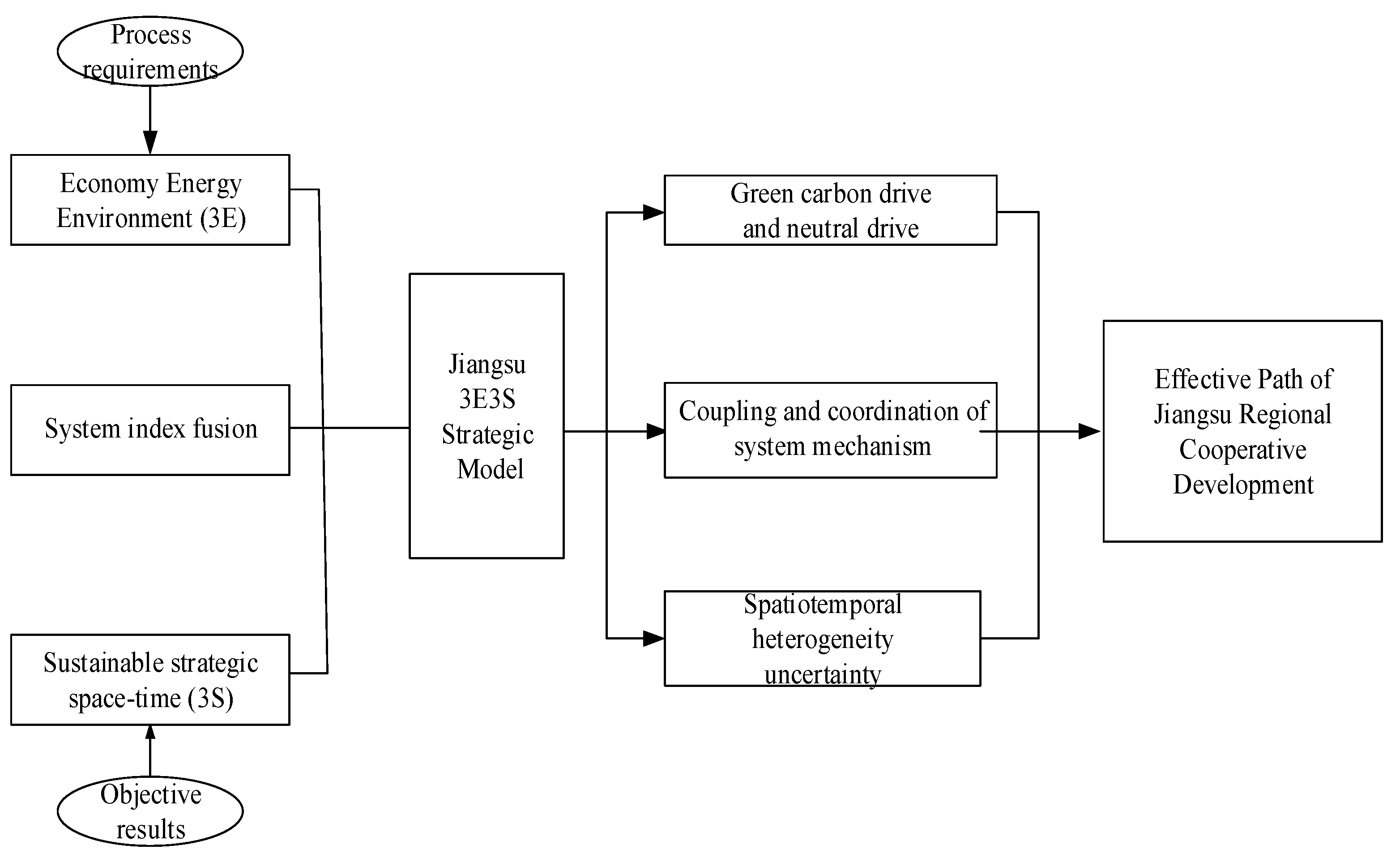
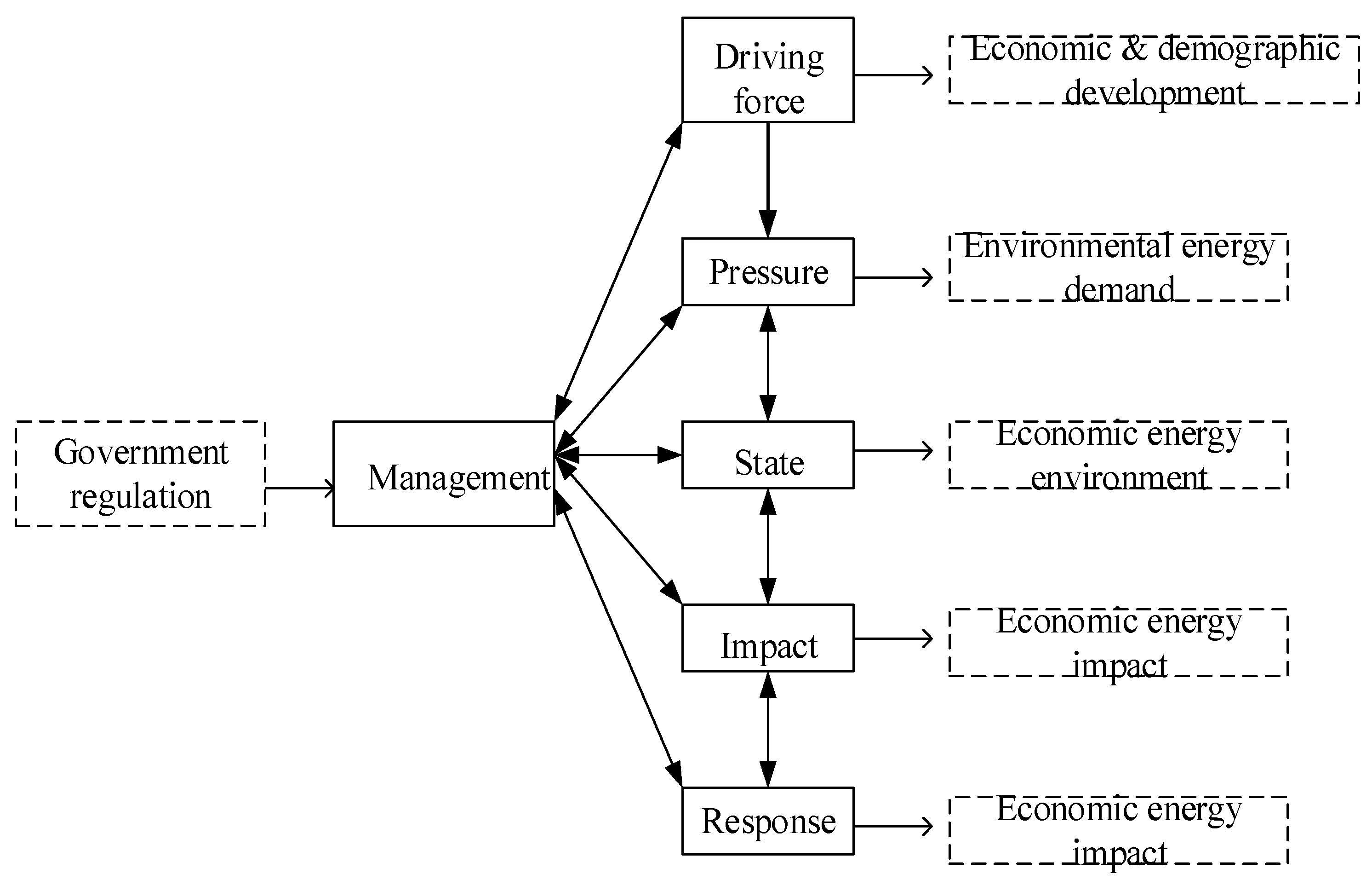
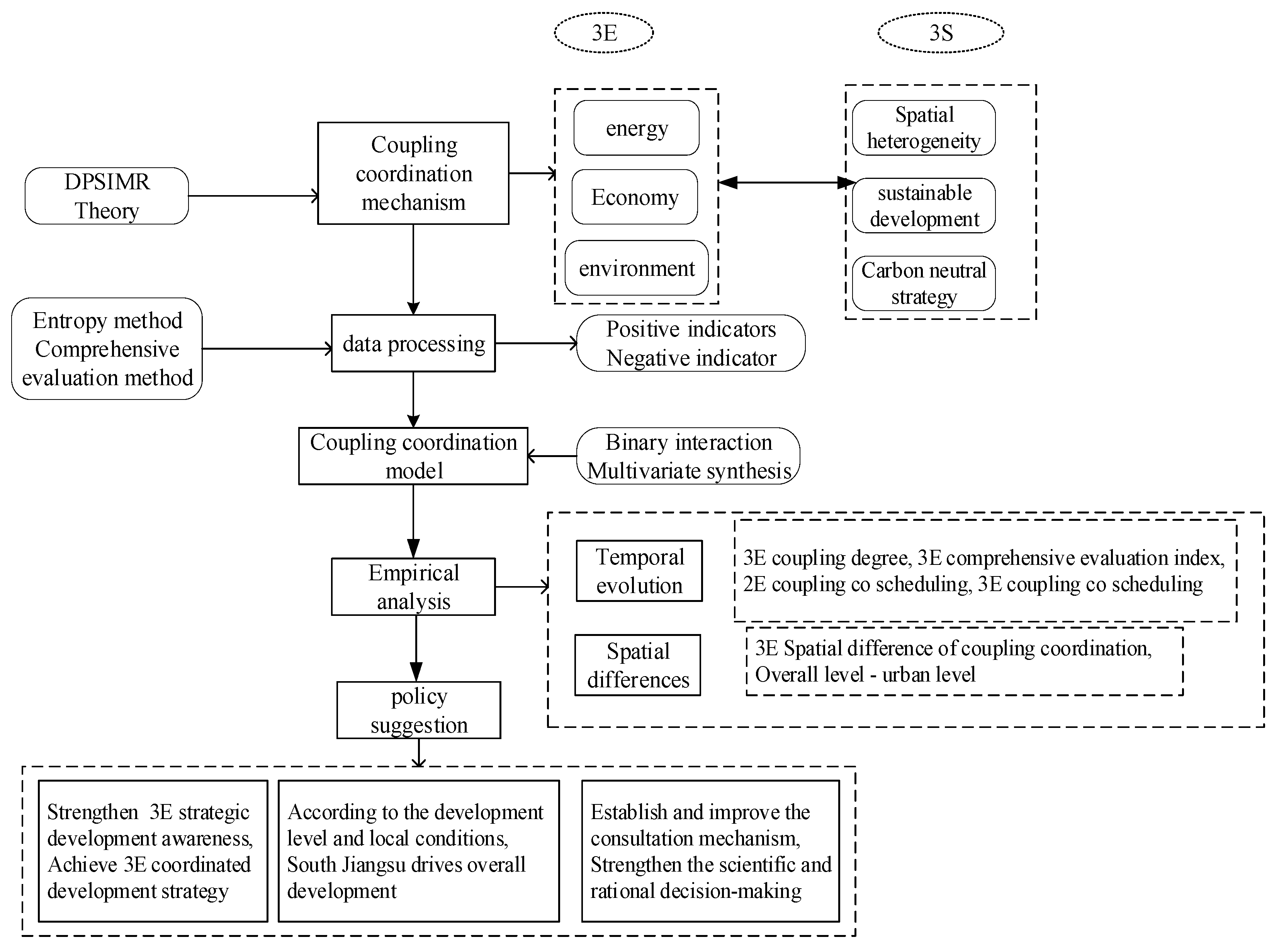

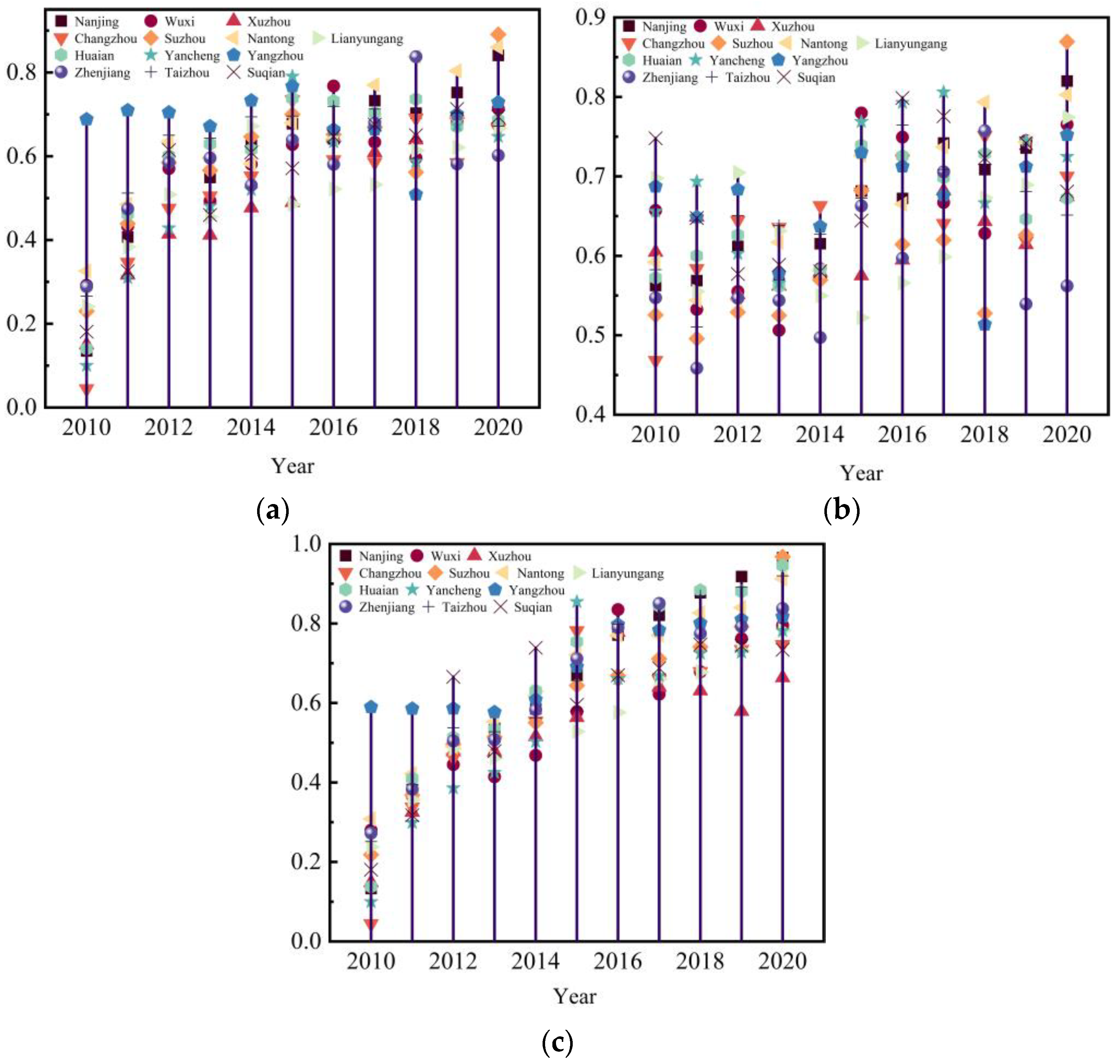

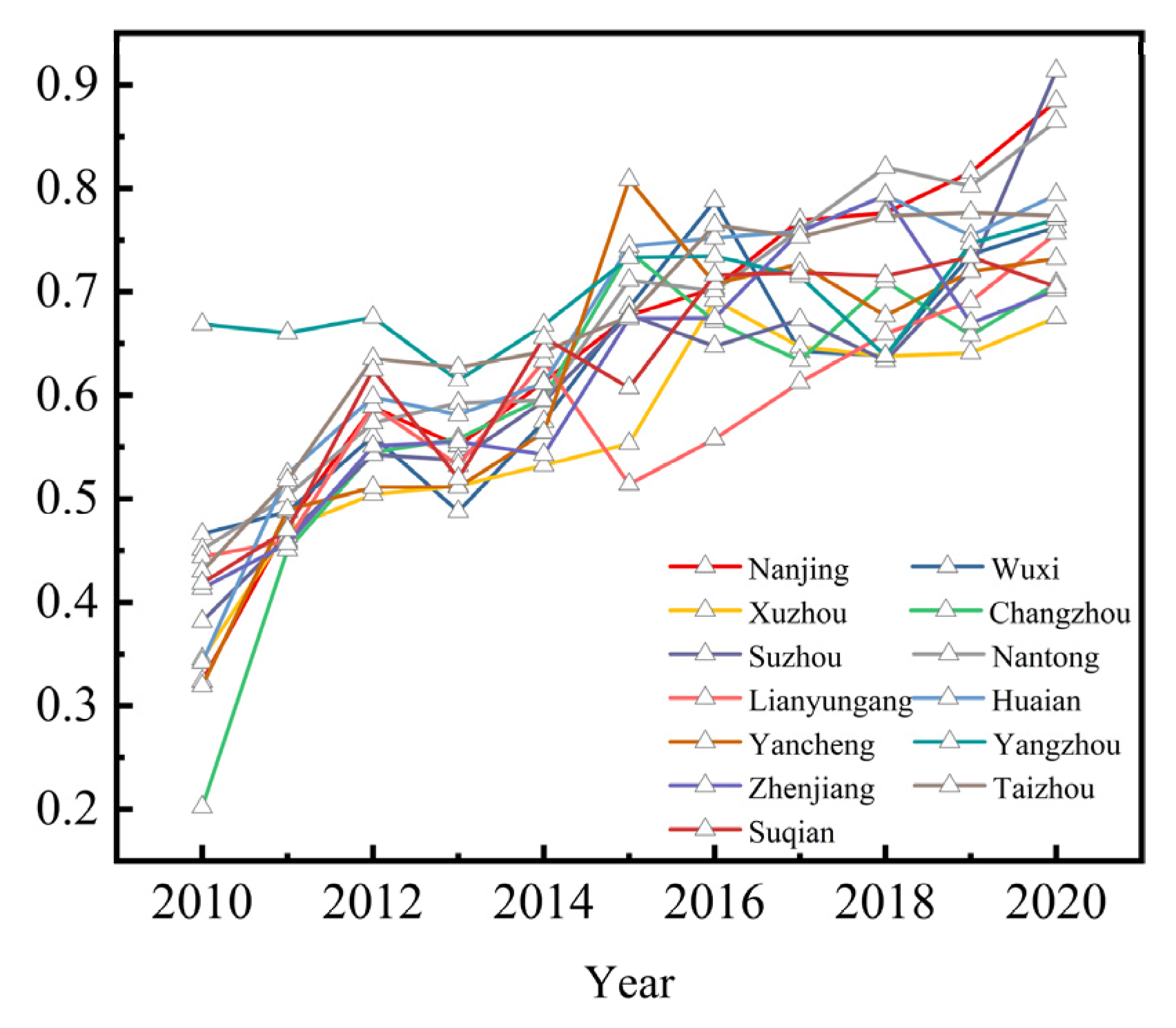
| Dimension | Theory | Indicator | Unit | Attribute |
|---|---|---|---|---|
| Economy | Driving force | AGDP | CNY | + |
| Urban population ratio | % | + | ||
| State | Per capita income | CNY | + | |
| Increase rate of tertiary industry | % | + | ||
| Impact | PCIER | % | + | |
| GNI | CNY | + | ||
| PCE | CNY | + | ||
| Social labor productivity | % | + | ||
| Response | R&D | Million CNY | + | |
| Energy | Pressure | Energy consumption/GDP | 100 tons/million y | − |
| ECPC | tons/people | − | ||
| State | Industrial power consumption | 100 million kWh | − | |
| Social electricity consumption | 100 million kWh | − | ||
| Energy-consumption growth | % | − | ||
| Impact | Energy-consumption elasticity | % | − | |
| Environment | Pressure | Industrial SO2 emissions | Tons | + |
| Industrial wastewater discharge | 10,000 tons | + | ||
| Industrial dust emissions | Tons | + | ||
| State | Urban precipitation | Millimeters | − | |
| Total water resources | Billion m3 | − | ||
| Response | Utilization rate of industrial solid waste | % | − | |
| Urban sewage-treatment rate | % | + | ||
| Harmless disposal of garbage | % | + | ||
| Management | Environmental-protection expenditure | Million CNY | + | |
| Greening coverage | % | + |
| Sustainable-Development Indicators | 3E Coupling-System Index | |
|---|---|---|
| Economy | Scale Structure Benefit Ability | AGDP |
| Urban population ratio | ||
| Per capita income | ||
| Increase rate of tertiary industry | ||
| PCIER | ||
| Social labor productivity | ||
| R&D | ||
| Resource | Energy | Energy consumption/GDP |
| Mineral products | ECPC | |
| Water | Industrial power consumption | |
| Land | Social electricity consumption | |
| Forest | Energy-consumption growth | |
| Ocean | Energy-consumption elasticity | |
| Environment | Water Atmosphere Waste material Noise Land Natural disaster Biodiversity | Urban precipitation |
| Total water resources | ||
| Industrial SO2 emissions | ||
| Industrial wastewater discharge | ||
| Industrial dust emissions | ||
| Utilization rate of industrial solid waste | ||
| Urban sewage-treatment rate | ||
| Harmless disposal of garbage | ||
| Environmental-protection expenditure | ||
| Greening coverage |
| Carbon-Neutral Strategy | 3E Coupling-System Evaluation | |
|---|---|---|
| Energy-structure adjustment | Improving energy use | Energy consumption/GDP |
| ECPC | ||
| Energy-consumption growth | ||
| Reducing fossil-energy use | Social electricity consumption | |
| Urban precipitation | ||
| Increasing clean-energy use | Environmental-protection expenditure | |
| Urban sewage-treatment rate | ||
| Harmless disposal of garbage | ||
| Greening coverage | ||
| Emissions reduction in key areas | Manufacturing industry Construction business | Industrial power consumption |
| Industrial SO2 emissions | ||
| Industrial wastewater discharge | ||
| Industrial dust emissions | ||
| Utilization rate of industrial solid waste | ||
| Agriculture | ||
| Transportation | ||
| Financial-abatement support | - | |
| Coupling-Coordination Degree D(t) | Partition Threshold D(t) | Types of Coupling Coordination |
|---|---|---|
| Dysregulation-regression area | [0, 0.1) | Extreme disorder decline |
| [0.1, 0.2) | Dysregulated decline | |
| [0.2, 0.3) | Moderate disorder decline | |
| [0.3, 0.4) | Mild disorder decline | |
| Transition-reconciliation area | [0.4, 0.5) | Moribund decline |
| [0.5, 0.6) | Barely coordinated development | |
| Coordinated-development areas | [0.6, 0.7) | Primary coordination development |
| [0.7, 0.8) | Intermediate-level coordinated development | |
| [0.8, 0.9) | Well-coordinated development | |
| [0.9, 1) | Quality coordinated development |
| Dimension | Theory | Indicator | Unit |
|---|---|---|---|
| Economy | Driving force | AGDP | 0.0841 |
| Urban population ratio | 0.0979 | ||
| State | Per capita income | 0.0817 | |
| Increase rate of tertiary industry | 0.0858 | ||
| Impact | PCIER | 0.0766 | |
| GNI | 0.1204 | ||
| PCE | 0.0862 | ||
| Social labor productivity | 0.2790 | ||
| Response | R&D | 0.0883 | |
| Energy | Pressure | Energy consumption/GDP | 0.1161 |
| ECPC | 0.1948 | ||
| State | Industrial power consumption | 0.1681 | |
| Social electricity consumption | 0.1828 | ||
| Energy-consumption growth | 0.1137 | ||
| Impact | Energy-consumption elasticity | 0.2245 | |
| Environment | Pressure | Industrial SO2 emissions | 0.0838 |
| Industrial wastewater discharge | 0.1161 | ||
| Industrial dust emissions | 0.1464 | ||
| State | Urban precipitation | 0.1037 | |
| Total water resources | 0.1025 | ||
| Response | Utilization rate of industrial solid waste | 0.0616 | |
| Urban sewage-treatment rate | 0.1060 | ||
| Harmless disposal of garbage | 0.0810 | ||
| Management | Environmental-protection expenditure | 0.0768 | |
| Greening coverage | 0.1223 |
| Year | Economy | Energy | Environment | Index | Coupling | Degree |
|---|---|---|---|---|---|---|
| 2010 | 0.1497 | 0.6381 | 0.2740 | 0.3206 | 0.5104 | 0.4004 |
| 2011 | 0.1264 | 0.5555 | 0.2634 | 0.3151 | 0.7869 | 0.4946 |
| 2012 | 0.2556 | 0.5665 | 0.3044 | 0.3755 | 0.8923 | 0.5769 |
| 2013 | 0.2458 | 0.4267 | 0.3149 | 0.3291 | 0.9317 | 0.5523 |
| 2014 | 0.3861 | 0.4282 | 0.3378 | 0.3840 | 0.9491 | 0.6019 |
| 2015 | 0.4543 | 0.4779 | 0.4922 | 0.4748 | 0.9771 | 0.6769 |
| 2016 | 0.5126 | 0.3974 | 0.6370 | 0.5157 | 0.9584 | 0.7008 |
| 2017 | 0.5134 | 0.4272 | 0.6068 | 0.5158 | 0.9696 | 0.7052 |
| 2018 | 0.5838 | 0.4030 | 0.6246 | 0.5371 | 0.9528 | 0.7127 |
| 2019 | 0.6701 | 0.3966 | 0.6217 | 0.5628 | 0.9466 | 0.7281 |
| 2020 | 0.7318 | 0.4375 | 0.7290 | 0.6328 | 0.9516 | 0.7724 |
| Type | City | CCD in 2010 | CCD in 2014 | CCD in 2017 | CCD in 2020 |
|---|---|---|---|---|---|
| Southern Jiangsu | Nanjing | 0.3236 | 0.6132 | 0.7691 | 0.8842 |
| Suzhou | 0.3816 | 0.5947 | 0.6730 | 0.9136 | |
| Wuxi | 0.4660 | 0.5746 | 0.6423 | 0.7626 | |
| Changzhou | 0.2020 | 0.5972 | 0.6336 | 0.7080 | |
| Zhenjiang | 0.4134 | 0.5427 | 0.7582 | 0.7016 | |
| Central Jiangsu | Yangzhou | 0.6686 | 0.6680 | 0.7149 | 0.7700 |
| Taizhou | 0.4299 | 0.6423 | 0.7530 | 0.7735 | |
| Nantong | 0.4511 | 0.5950 | 0.7601 | 0.8650 | |
| Northern Jiangsu | Xuzhou | 0.3452 | 0.5325 | 0.6470 | 0.6752 |
| Lianyung | 0.4439 | 0.6331 | 0.6125 | 0.7567 | |
| Suqian | 0.4184 | 0.6559 | 0.7182 | 0.7047 | |
| Huaian | 0.3419 | 0.6117 | 0.7584 | 0.7938 | |
| Yancheng | 0.3194 | 0.5639 | 0.7268 | 0.7321 |
Disclaimer/Publisher’s Note: The statements, opinions and data contained in all publications are solely those of the individual author(s) and contributor(s) and not of MDPI and/or the editor(s). MDPI and/or the editor(s) disclaim responsibility for any injury to people or property resulting from any ideas, methods, instructions or products referred to in the content. |
© 2023 by the authors. Licensee MDPI, Basel, Switzerland. This article is an open access article distributed under the terms and conditions of the Creative Commons Attribution (CC BY) license (https://creativecommons.org/licenses/by/4.0/).
Share and Cite
Ye, J.; Tian, L.; Zhou, Y. Regional Energy–Economy–Environment Coupling Coordinated Development System Driven by Carbon Peaking and Carbon Neutralization over 13 Cities in Jiangsu Province. Sustainability 2023, 15, 1588. https://doi.org/10.3390/su15021588
Ye J, Tian L, Zhou Y. Regional Energy–Economy–Environment Coupling Coordinated Development System Driven by Carbon Peaking and Carbon Neutralization over 13 Cities in Jiangsu Province. Sustainability. 2023; 15(2):1588. https://doi.org/10.3390/su15021588
Chicago/Turabian StyleYe, Jing, Lixin Tian, and Yuwen Zhou. 2023. "Regional Energy–Economy–Environment Coupling Coordinated Development System Driven by Carbon Peaking and Carbon Neutralization over 13 Cities in Jiangsu Province" Sustainability 15, no. 2: 1588. https://doi.org/10.3390/su15021588
APA StyleYe, J., Tian, L., & Zhou, Y. (2023). Regional Energy–Economy–Environment Coupling Coordinated Development System Driven by Carbon Peaking and Carbon Neutralization over 13 Cities in Jiangsu Province. Sustainability, 15(2), 1588. https://doi.org/10.3390/su15021588






